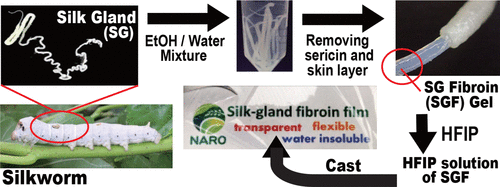当前位置:
X-MOL 学术
›
ACS Biomater. Sci. Eng.
›
论文详情
Our official English website, www.x-mol.net, welcomes your
feedback! (Note: you will need to create a separate account there.)
Fabrication Scheme for Obtaining Transparent, Flexible, and Water-Insoluble Silk Films from Apparently Dissolved Silk-Gland Fibroin of Bombyx mori Silkworm
ACS Biomaterials Science & Engineering ( IF 5.4 ) Pub Date : 2017-11-30 00:00:00 , DOI: 10.1021/acsbiomaterials.7b00602 Taiyo Yoshioka 1 , Tamako Hata 1 , Katsura Kojima 1 , Yasumoto Nakazawa 2 , Tsunenori Kameda 1
ACS Biomaterials Science & Engineering ( IF 5.4 ) Pub Date : 2017-11-30 00:00:00 , DOI: 10.1021/acsbiomaterials.7b00602 Taiyo Yoshioka 1 , Tamako Hata 1 , Katsura Kojima 1 , Yasumoto Nakazawa 2 , Tsunenori Kameda 1
Affiliation

|
Films from silk fibroin protein are one of the most promising biomaterials because of their exquisite balance between mechanical properties and biocompatibility. Numerous schemes have been proposed for processing fibroin film, utilizing liquid silk fibroin (LSF) or regenerated silk fibroin (RSF). The films cast from LSF or RSF in the solution state are water-soluble, and therefore require postproduction treatment inducing β-sheet formation, to render them insoluble in water. Many kinds of postproduction treatments, using alcohol–water solution, water vapor, or controlled temperature, have been developed. However, the tuning and reproducibility of such treatments are quite sensitive and frequently render the fibroin films less flexible or even brittle because of the formation of an over content of β-sheet. To overcome this, we developed a novel scheme for fibroin processing using silk-gland fibroin (SGF). The essence of this scheme is to create a softly solidified fibroin-gel state of the silk glands with an imperfect β-sheet structure, by treating them with an ethanol/water mixture. Such a fibroin gel was found to dissolve in 1,1,1,3,3,3-hexafluoro-2-propanol (HFIP). The SGF film cast from the HFIP solution shows a flexible and water-insoluble nature with high reproducibility. In addition to this improvement, the SGF film produced by this method contains a significantly low level of residual HFIP molecules compared to the traditional RSF films prepared from an HFIP solution. The mechanism underlying these advantageous characteristics was investigated from the structural viewpoint, by using techniques such as 13C solid-state NMR, differential scanning calorimetry, and wide-angle X-ray diffraction.
中文翻译:

制造方案从显然溶丝腺素得到透明,柔韧性好,不溶于水的丝素膜家蚕蚕
丝纤蛋白蛋白膜由于其机械性能和生物相容性之间的精妙平衡而成为最有前途的生物材料之一。已经提出了许多利用液体丝素蛋白(LSF)或再生丝素蛋白(RSF)来处理丝蛋白膜的方案。由LSF或RSF流延成溶液的薄膜是水溶性的,因此需要进行后期处理以诱导形成β-片层,使其不溶于水。已经开发出了许多使用酒精水溶液,水蒸气或受控温度的后期处理方法。但是,这种处理的调节和可重复性非常敏感,并且由于形成过量的β-片层而经常使纤维蛋白膜的柔韧性降低甚至脆化。为了克服这个问题 我们开发了一种使用丝腺纤维蛋白(SGF)进行纤维蛋白加工的新方案。该方案的实质是通过用乙醇/水混合物处理,从而使蚕丝腺的软化纤维蛋白-凝胶状态具有不完美的β-折叠结构。发现这种纤维蛋白凝胶溶解在1,1,1,3,3,3-六氟-2-丙醇(HFIP)中。由HFIP溶液浇铸的SGF膜具有柔韧性和水不溶性,并具有很高的重现性。除了这一改进之外,与由HFIP溶液制备的传统RSF膜相比,通过这种方法生产的SGF膜还含有少量的残留HFIP分子。从结构的角度,通过使用诸如 该方案的实质是通过用乙醇/水混合物处理,从而使蚕丝腺的软化纤维蛋白-凝胶状态具有不完美的β-折叠结构。发现这种纤维蛋白凝胶溶解在1,1,1,3,3,3-六氟-2-丙醇(HFIP)中。由HFIP溶液浇铸的SGF膜具有柔韧性和水不溶性,并具有很高的重现性。除了这一改进之外,与由HFIP溶液制备的传统RSF膜相比,通过这种方法生产的SGF膜还含有少量的残留HFIP分子。从结构的角度,通过使用诸如 该方案的实质是通过用乙醇/水混合物处理,从而使蚕丝腺的软化纤维蛋白-凝胶状态具有不完美的β-折叠结构。发现这种纤维蛋白凝胶溶解在1,1,1,3,3,3-六氟-2-丙醇(HFIP)中。由HFIP溶液浇铸的SGF膜具有柔韧性和水不溶性,并具有很高的重现性。除了这一改进之外,与由HFIP溶液制备的传统RSF膜相比,通过这种方法生产的SGF膜还含有少量的残留HFIP分子。从结构的角度,通过使用诸如 通过用乙醇/水混合物处理它们。发现这种纤维蛋白凝胶溶解在1,1,1,3,3,3-六氟-2-丙醇(HFIP)中。由HFIP溶液浇铸的SGF膜具有柔韧性和水不溶性,并具有很高的重现性。除了这一改进之外,与由HFIP溶液制备的传统RSF膜相比,通过这种方法生产的SGF膜还含有少量的残留HFIP分子。从结构的角度,通过使用诸如 通过用乙醇/水混合物处理它们。发现这种纤维蛋白凝胶溶解在1,1,1,3,3,3-六氟-2-丙醇(HFIP)中。由HFIP溶液浇铸的SGF膜具有柔韧性和水不溶性,并具有很高的重现性。除了这一改进之外,与由HFIP溶液制备的传统RSF膜相比,通过这种方法生产的SGF膜还含有少量的残留HFIP分子。从结构的角度,通过使用诸如 与用HFIP溶液制备的传统RSF膜相比,用这种方法生产的SGF膜含有低水平的残留HFIP分子。从结构的角度,通过使用诸如 与用HFIP溶液制备的传统RSF膜相比,用这种方法生产的SGF膜含有低水平的残留HFIP分子。从结构的角度,通过使用诸如13 C固态NMR,差示扫描量热法和广角X射线衍射。
更新日期:2017-11-30
中文翻译:

制造方案从显然溶丝腺素得到透明,柔韧性好,不溶于水的丝素膜家蚕蚕
丝纤蛋白蛋白膜由于其机械性能和生物相容性之间的精妙平衡而成为最有前途的生物材料之一。已经提出了许多利用液体丝素蛋白(LSF)或再生丝素蛋白(RSF)来处理丝蛋白膜的方案。由LSF或RSF流延成溶液的薄膜是水溶性的,因此需要进行后期处理以诱导形成β-片层,使其不溶于水。已经开发出了许多使用酒精水溶液,水蒸气或受控温度的后期处理方法。但是,这种处理的调节和可重复性非常敏感,并且由于形成过量的β-片层而经常使纤维蛋白膜的柔韧性降低甚至脆化。为了克服这个问题 我们开发了一种使用丝腺纤维蛋白(SGF)进行纤维蛋白加工的新方案。该方案的实质是通过用乙醇/水混合物处理,从而使蚕丝腺的软化纤维蛋白-凝胶状态具有不完美的β-折叠结构。发现这种纤维蛋白凝胶溶解在1,1,1,3,3,3-六氟-2-丙醇(HFIP)中。由HFIP溶液浇铸的SGF膜具有柔韧性和水不溶性,并具有很高的重现性。除了这一改进之外,与由HFIP溶液制备的传统RSF膜相比,通过这种方法生产的SGF膜还含有少量的残留HFIP分子。从结构的角度,通过使用诸如 该方案的实质是通过用乙醇/水混合物处理,从而使蚕丝腺的软化纤维蛋白-凝胶状态具有不完美的β-折叠结构。发现这种纤维蛋白凝胶溶解在1,1,1,3,3,3-六氟-2-丙醇(HFIP)中。由HFIP溶液浇铸的SGF膜具有柔韧性和水不溶性,并具有很高的重现性。除了这一改进之外,与由HFIP溶液制备的传统RSF膜相比,通过这种方法生产的SGF膜还含有少量的残留HFIP分子。从结构的角度,通过使用诸如 该方案的实质是通过用乙醇/水混合物处理,从而使蚕丝腺的软化纤维蛋白-凝胶状态具有不完美的β-折叠结构。发现这种纤维蛋白凝胶溶解在1,1,1,3,3,3-六氟-2-丙醇(HFIP)中。由HFIP溶液浇铸的SGF膜具有柔韧性和水不溶性,并具有很高的重现性。除了这一改进之外,与由HFIP溶液制备的传统RSF膜相比,通过这种方法生产的SGF膜还含有少量的残留HFIP分子。从结构的角度,通过使用诸如 通过用乙醇/水混合物处理它们。发现这种纤维蛋白凝胶溶解在1,1,1,3,3,3-六氟-2-丙醇(HFIP)中。由HFIP溶液浇铸的SGF膜具有柔韧性和水不溶性,并具有很高的重现性。除了这一改进之外,与由HFIP溶液制备的传统RSF膜相比,通过这种方法生产的SGF膜还含有少量的残留HFIP分子。从结构的角度,通过使用诸如 通过用乙醇/水混合物处理它们。发现这种纤维蛋白凝胶溶解在1,1,1,3,3,3-六氟-2-丙醇(HFIP)中。由HFIP溶液浇铸的SGF膜具有柔韧性和水不溶性,并具有很高的重现性。除了这一改进之外,与由HFIP溶液制备的传统RSF膜相比,通过这种方法生产的SGF膜还含有少量的残留HFIP分子。从结构的角度,通过使用诸如 与用HFIP溶液制备的传统RSF膜相比,用这种方法生产的SGF膜含有低水平的残留HFIP分子。从结构的角度,通过使用诸如 与用HFIP溶液制备的传统RSF膜相比,用这种方法生产的SGF膜含有低水平的残留HFIP分子。从结构的角度,通过使用诸如13 C固态NMR,差示扫描量热法和广角X射线衍射。











































 京公网安备 11010802027423号
京公网安备 11010802027423号